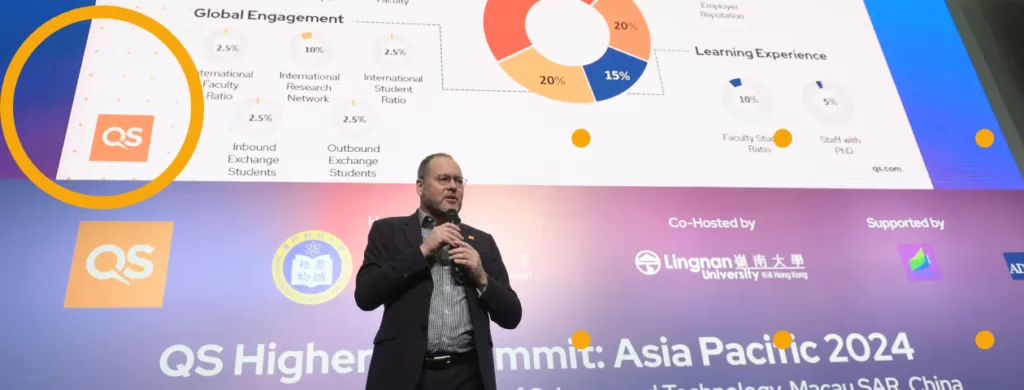
Written by Dr Helen Kelly, QS Principal Consultant for QS Insights Magazine

The global higher education sector has undergone significant change in recent times. Senior leadership teams around the world find themselves grappling with the intricacies of juggling operational and strategic priorities amid the backdrop of financial constraints. A particular focus of concern is the complex relationship between international student recruitment and sustainability strategies within universities and pondering how these seemingly disparate objectives can be balanced.
Student mobility in the pursuit of knowledge
One of the central tenants of higher education is the mobility of our students and staff across the learning, teaching and research landscape. Collaboration and interconnectivity define our pursuit of knowledge and excellence and drives innovation within our universities for a solutions-oriented approach to global challenges. This emphasis on dynamic engagement underscores the transformative role higher education plays in not only disseminating knowledge, but actively contributing to resolving complex issues on a global scale.
Enabling students to be part of this vision has long been central to our shared educational mission of preparing each generation of students for the ever-changing world they are part of. But a harsh reality for the majority of higher education institutions is the growing financial reliance on international student recruitment income to cross-subsidise core funding models within home jurisdictions. Pre-pandemic, in-person travel from academic, professional services and senior leadership colleagues had become common place in order to expand global reach and secure recurring international fee income.
How then do we balance this financial imperative with our increasing understanding of, and commitment to, sustainability? How do we not only attract diverse talent, but also foster a sustainable and environmentally responsible learning environment? There is growing evidence that international students are acutely engaged with issues of sustainability and increasingly seek to study with universities that have a strong commitment to sustainability. In the QS Sustainability Student Survey 2022, 79 percent of students expressed a desire to see the university they apply to reduce its carbon footprint; while 44 percent actively seek out information on the institution’s sustainability model.
These credentials no longer only cover the development of a green campus, but rather encompass integrated sustainable practices across the university lifecycle from recruitment strategies and travel policy to portfolio development and pedagogical approaches. The importance of offering a portfolio that reflects both the passions of students and responds to workplace needs is a growing priority of many institutions, along with an understanding of subject-level trends across and within distinct regions. Courses focused on environmental stewardship, sustainable business practices and social responsibility are becoming integral parts of diverse academic programmes and actively reflect the study choices of environmentally conscious students and the acquisition of graduate skills and outcomes.
Changing student preferences
But what of recruiting international students for our programmes? When the world ‘stopped’ in 2020, so did higher education travel. Both our on-campus and in-region teaching moved online, and we navigated our student recruitment activity and partnership development through a virtual world. We routinely provided virtual campus tours, online information sessions and webinars to reach an international student audience without any in-person travel or communication.
Post-pandemic, there is clear evidence that students with the financial means to do so prefer to study in person. Of the international students surveyed in the 2023 International Student Survey, for example, 58 percent of those looking to study in the UK indicated a preference for in-person learning as opposed to 24 percent for online. This reverse shift has a clear impact across a range of sustainability indicators including the international student carbon footprint. The moving away from online provision in regions such as mainland China will further contribute to this as students seek to experience the benefits of an in-person international experience. But accelerated innovation and development of the virtual learning environment during the pandemic years has further elevated the distance learning model and will continue to provide a valuable alternative pathway for many international students while also directly contributing to a sustainability agenda.
In the QS Sustainability Student Survey 2022, 79 percent of students expressed a desire to see the university they apply to reduce its carbon footprint
Allied to this is transnational education provision (TNE). Our heightened awareness of environmental responsibilities adds a further dimension to TNE and positions it as a strategic avenue for international students that seek an in-person educational experience without the ecological costs associated with travel. This, of course, depends on the operating model with ‘flying faculty’ and in some cases, branch campuses, generating their own set of sustainability challenges. The future development of TNE provision and partnerships will no doubt continue to evolve as governments and industry engage more fully with higher education to rethink innovative and sustainable solutions to international education in a local context.
As a sector, we are still in the process of understanding and interpreting the impact of the Covid years and how the global landscape has shifted as a result, not least around student demand, expectations and preferences. At institutional level, much work is currently underway by universities to understand and offset their travel related emissions, while also being sensitive to the operational necessities of staff and student mobility. These conflicting drivers and priorities create challenges for all of us engaged in higher education and there are no easy or straightforward answers. Balancing the scales between international student recruitment and sustainability will require a thoughtful, strategic, and on-going commitment in our attempts to create a sustainable and inclusive global education environment.



